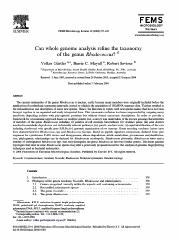Please use this identifier to cite or link to this item:
https://ahro.austin.org.au/austinjspui/handle/1/9813| Title: | Can whole genome analysis refine the taxonomy of the genus Rhodococcus? | Austin Authors: | Gürtler, Volker;Mayall, Barrie C;Seviour, Robert | Affiliation: | Department of Microbiology, Austin Health, Studley Road, Heidelberg, Vic. 3084, Australia | Issue Date: | 1-Jun-2004 | Publication information: | Fems Microbiology Reviews; 28(3): 377-403 | Abstract: | The current systematics of the genus Rhodococcus is unclear, partly because many members were originally included before the application of a polyphasic taxonomic approach, central to which is the acquisition of 16S rRNA sequence data. This has resulted in the reclassification and description of many new species. Hence, the literature is replete with new species names that have not been brought together in an organized and easily interpreted form. This taxonomic confusion has been compounded by assigning many xenobiotic degrading isolates with phylogenetic positions but without formal taxonomic descriptions. In order to provide a framework for a taxonomic approach based on multiple genetic loci, a survey was undertaken of the known genome characteristics of members of the genus Rhodococcus including: (i) genetics of cell envelope biosynthesis; (ii) virulence genes; (iii) gene clusters involved in metabolic degradation and industrially relevant pathways; (iv) genetic analysis tools; (v) rapid identification of bacteria including rhodococci with specific gene RFLPs; (vi) genomic organization of rrn operons. Genes encoding virulence factors have been characterized for Rhodococcus equi and Rhodococcus fascians. Based on peptide signature comparisons deduced from gene sequences for cytochrome P-450, mono- and dioxygenases, alkane degradation, nitrile metabolism, proteasomes and desulfurization, phylogenetic relationships can be deduced for Rhodococcus erythropolis, Rhodococcus globerulus, Rhodococcus ruber and a number of undesignated Rhodococcus spp. that may distinguish the genus Rhodococcus into two further genera. The linear genome topologies that exist in some Rhodococcus species may alter a previously proposed model for the analysis of genomic fingerprinting techniques used in bacterial systematics. | Gov't Doc #: | 15449609 | URI: | https://ahro.austin.org.au/austinjspui/handle/1/9813 | Journal: | FEMS microbiology reviews | URL: | https://pubmed.ncbi.nlm.nih.gov/15449609 | Type: | Journal Article | Subjects: | Actinobacteria.classification.genetics Cell Membrane.metabolism Chromosome Mapping Genome, Bacterial Genomics Gordonia Bacterium.classification.genetics Models, Biological Multigene Family Nocardia.classification.genetics Phylogeny RNA, Bacterial.genetics RNA, Ribosomal, 16S.genetics Rhodococcus.classification.genetics.metabolism |
| Appears in Collections: | Journal articles |
Files in This Item:
| File | Description | Size | Format | |
|---|---|---|---|---|
| 15449609.pdf | 654.43 kB | Adobe PDF |  View/Open |
Page view(s)
96
checked on Feb 22, 2025
Download(s)
150
checked on Feb 22, 2025
Google ScholarTM
Check
Items in AHRO are protected by copyright, with all rights reserved, unless otherwise indicated.
